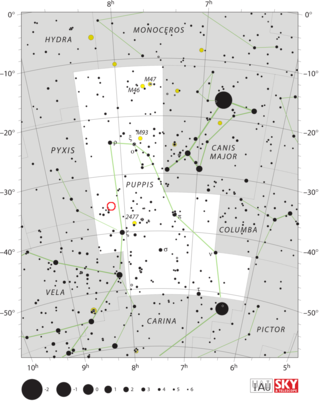
CP Puppis was a bright nova occurring in the constellation Puppis in 1942. The nova was discovered on 9 November 1942 by Bernhard Dawson at La Plata, Argentina, when it had an apparent visual magnitude of about 2. It was independently discovered at 18:00 10 November 1942 (UT) by a 19-year-old Japanese schoolgirl, Kuniko Sofue, who looked at the sky after patching her socks and noticed the nova. For this discovery, asteroid 7189 Kuniko was named in her honor.

T Aurigae was a nova, which lit up in the constellation Auriga in 1891. Thomas David Anderson, an amateur astronomer in Edinburgh, reported that he was "almost certain" he saw the nova at 02:00 UT on 24 January 1892, when it was slightly brighter than χ Aurigae. He mistook the star for 26 Aurigae, although he noted to himself that it seemed brighter than he remembered it being. He saw it twice more during the following week. On 31 January 1892 he realized his mistake, and wrote a note to Ralph Copeland reporting his discovery. Professor Copeland immediately reported the discovery via telegram to William Huggins, who made the first spectroscopic observations of T Aurigae on 2 February 1892, when the star was a magnitude 4.5 object. T Aurigae was the first nova to be observed spectroscopically.

CP Lacertae was a nova, which lit up on June 18, 1936 in the constellation Lacerta. It was discovered independently by several observers including Leslie Peltier in the US, E. Loreta in Italy, and Kazuaki Gomi, a Japanese barber who discovered the nova during the 19 June 1936 total solar eclipse.
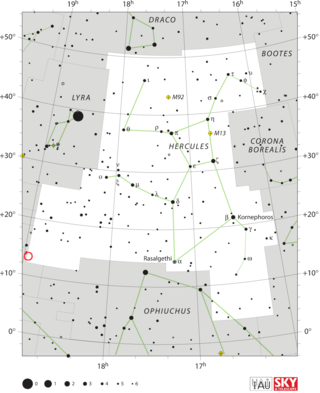
V446 Herculis was a nova in the constellation Hercules in 1960. It reached magnitude 2.8. The nova was first observed by Olaf Hassel in the early morning hours of 7 March 1960, when it was a 5th magnitude star. Pre-discovery photographs showed that it was about three days past peak brightness, and had faded by 2 magnitudes during that time. The star was so near the border between the constellations of Hercules and Aquila that accurate measurements of its position were needed to determine which constellation contained it.

V533 Herculis was a nova visible to the naked eye, which occurred in 1963 in the constellation of Hercules.

V373 Scuti was a nova which appeared in 1975 in the southern constellation of Scutum. It was announced on June 15, 1975 by Paul Wild at the Zimmerwald Observatory, Switzerland. At the time the magnitude was about 7.9. The peak magnitude of 7.1 occurred a month earlier on May 11.

NQ Vulpeculae also known as Nova Vulpeculae 1976, was a nova that appeared in the constellation Vulpecula in 1976. It was discovered visually at 18:20 UT on October 21, 1976 by English amateur astronomer George Alcock. Its apparent magnitude at the time of discovery was 6.5 It reached its maximum brightness of magnitude 6.0 thirteen days after its discovery, at which point it may have been faintly visible to the naked eye. A few days after maximum brightness, it had faded to magnitude 8.3.

DK Lacertae was a nova, which lit up in the constellation Lacerta in 1950. The nova was discovered by Charles Bertaud of the Paris Observatory on a photographic plate taken on 23 January 1950. At the time of its discovery, it had an apparent magnitude of 6.1. DK Lacertae reached peak magnitude 5.0, making it easily visible to the naked eye.
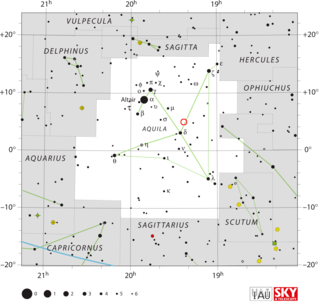
V1494 Aquilae or Nova Aquilae 1999 b was a nova which occurred during 1999 in the constellation Aquila and reached a brightness of magnitude 3.9 on 2 December 1999. making it easily visible to the naked eye. The nova was discovered with 14×100 binoculars by Alfredo Pereira of Cabo da Roca, Portugal at 18:50 UT on 1 December 1999, when it had a visual magnitude of 6.0.

Lambda Centauri, Latinized from λ Centauri, is a star in the southern circumpolar constellation of Centaurus. It has an apparent visual magnitude of +3.13, which is bright enough to be seen with the naked eye from the Southern Hemisphere and places it among the brighter members of this constellation. The star is close enough that its distance can be determined directly using the parallax technique, which gives a value of approximately 470 light-years from the Sun. Although a putative solitary star, it has a candidate proper motion companion at an angular separation of 0.73 arcseconds along a position angle of 135°. The nebula IC 2944 lies nearby.

Nu Centauri, Latinized from ν Centauri, is a binary star system in the southern constellation of Centaurus. The combined apparent visual magnitude of the pair is +3.41, making this one of the brightest members of the constellation. Based upon parallax measurements made during the Hipparcos mission, this star system is located at a distance of roughly 437 light-years from Earth. The margin of error for this distance is about 2%, which is enough to give an error in distance of ±10 light years.
Sigma Centauri, Latinized from σ Centauri, is the Bayer designation for a solitary star in the southern constellation of Centaurus. It is visible to the naked eye with an apparent visual magnitude of 3.91. A visual companion at an angular separation of 88.11±0.37 mas along a position angle of 14.33°±2.59° was detected in 2010 using interferometry, but its association with Sigma Centauri remains undetermined as of 2013. The distance to Sigma Centauri, based upon an annual parallax shift of 7.92 mas, is around 412 light years.

Rho Centauri, Latinized from ρ Centauri, is a binary star system in the southern constellation of Centaurus. It is visible to the naked eye as a blue-white hued point of light with a combined apparent visual magnitude of +3.97. The system is located approximately 276 light years from the Sun based on parallax, and is drifting further away with a radial velocity of around +15 km/s. It is a proper motion member of the Lower Centaurus–Crux sub-group in the Scorpius–Centaurus OB association, the nearest such association of co-moving massive stars to the Sun.
HD 113703, also known by the Bayer designation f Centauri, is a multiple star system in the southern constellation of Centaurus. The combined apparent visual magnitude of this system is +4.71, which is sufficient to make it faintly visible to the naked eye. The distance to this system is approximately 400 light years based on parallax measurements. It is a member of the Lower Centaurus Crux subgroup of the Scorpius–Centaurus association.

Omicron1 Centauri is a star in the constellation Centaurus. It is approximately 10,000 light years from Earth.

V1017 Sagittarii is a cataclysmic variable star system in the constellation Sagittarius. It first erupted in 1919, reaching magnitude 7. Its other eruptions in 1901, 1973 and 1991 only reached magnitude 10, leading it to be reclassified from a recurrent nova to a dwarf nova.

WR 21a is an eclipsing binary star in the constellation Carina. It includes one of the most massive known stars and is one of the most massive binaries.
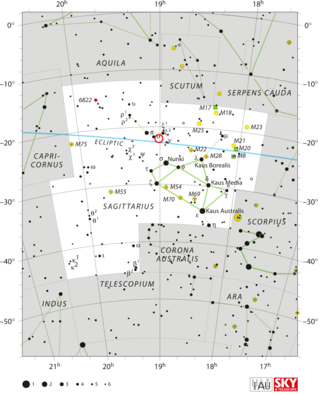
V4743 Sagittarii was a bright nova in the southern constellation of Sagittarius. This event was discovered by K. Haseda and colleagues in September 2002. It peaked at magnitude 5.0 on September 20, 2002, then declined rapidly thereafter. It reached a peak temperature of 740,000 K around April 2003 and remained at that level for at least five months, suggesting the white dwarf component has a mass of 1.1–1.2 M☉. The distance to this system is uncertain. Infrared observations indicate a distance of approximately 21 kly (6.3 kpc). A derivation using maximum magnitude rate of decay showed a distance of 12.7 ± 1.0 kly (3.9 ± 0.3 kpc).
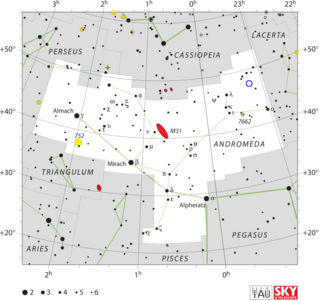
OS Andromedae, known also as Nova Andromedae 1986, is a classical nova that appeared in the constellation Andromeda during 1986. It was discovered at 10:34 UT on 5 December 1986 by Mitsuri Suzuki, a 28-year-old school teacher living in Ena, Japan. He photographed the portion of the Milky Way that passes through northern Andromeda with a 200-mm telephoto lens, and found the nova when its apparent magnitude was 8.0. Two days later it reached a peak apparent visual magnitude of 6.3.

V368 Aquilae, also known as Nova Aquilae 1936 no. 2 was the second nova which occurred in the constellation of Aquila during 1936. It was discovered on a photographic plate by Nils Tamm at Kvistaberg Observatory on 7 October 1936. At the time of discovery it was at photographic magnitude 7, and was already fading. Pre-discovery photographs showed that peak brightness occurred around 25 September 1936, at which time it had reached apparent magnitude 5.0, making it visible to the naked eye. The nova was described as being fiery red due to strong Hα emission, and for a time could be seen with binoculars simultaneously with V356 Aquilae, another nova which Nill Tamm had discovered a month earlier.

















